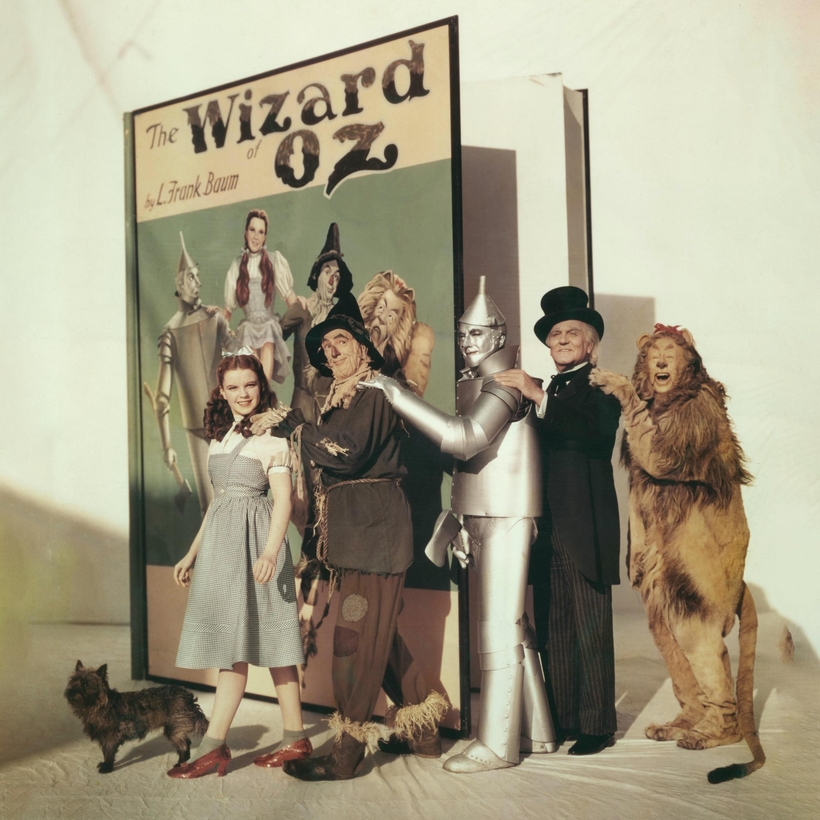I have a long and abiding interest in Oz. As a young child, I devoured book after book after book in the series. When L. Frank Baum died and was replaced by Ruth Plumly Thompson, I was perfectly happy: it meant I could continue to read about Oz. The joy was that it was endless. You could sink in and stay forever. The authorship was secondary. Although by the time Thompson gave it up and was replaced by a third writer, I, too, had had enough.
Gore Vidal asked, “Is it possible that Baum’s survival is due to the fact that he is not taught? That he is not, officially, Literature? If so, one must be careful not to murder Oz with exegesis.” Alas, there is an endless series of commentaries on The Wizard of Oz, both the book and the film. James Thurber, Ray Bradbury, and Salman Rushdie, not to mention countless unheralded scholars, have ignored Vidal’s advice.

Somehow, when confronted with words on a page, we always want to imagine they mean something different, something more than what they say. Much ink has been spilled making the case that The Wizard of Oz is in fact a thinly veiled allegory of the populist politics of the turn of the 20th century. The Cowardly Lion could be William Jennings Bryan; Dorothy’s slippers—they’re silver in the book—could represent the Free Silver Movement. (Even if true, I find this interpretation boring.)
For Bradbury, the obvious contrast is with Lewis Carroll’s Alice’s Adventures in Wonderland:
“Because in Oz of course reside amiable villains, who are really not villains at all.... Whereas Wonderland’s Queen of Hearts really does chop off heads and children are beaten if they sneeze.
“Wonderland is what we are.
“Oz is what we would hope and like to be.”
Rushdie ruminates on the importance of the film as a catalyst for his very first story, written when he was 10, titled “Over the Rainbow.” But Rushdie lashes out at Toto. “I couldn’t stand Toto! I still can’t,” he writes. “Toto: that little yapping hairpiece of a creature, that meddlesome rug! Frank Baum, excellent fellow, gave a distinctly minor role to the dog: it kept Dorothy happy, and when she wasn’t it had a tendency to ‘whine dismally’—not an endearing trait.... That Toto should be the film’s one true object of love has always rankled.”
Gore Vidal asked, “Is it possible that Baum’s survival is due to the fact that he is not taught? That he is not, officially, Literature? If so, one must be careful not to murder Oz with exegesis.”
I’m more than a little disappointed with Rushdie. He sounds a little like the governor of South Dakota. Take Toto down to the gravel pit. Well, Toto’s real name is Terry. And he is not a he but a she. Toto is a central device in both the film and the book, whether Rushdie likes it or not. It is the dog who exposes the Wizard for what he is: a humbug and a fraud.
Rushdie’s analysis of the movie I find peculiar. He opines that Dorothy’s line “There’s no place like home” is the least convincing idea in the film. How could Dorothy wish to return to colorless, shapeless Kansas when she has colorful, curious Oz to explore? I have to admit, I have no problem with it. Kansas is a dream—a dream of a perfect place, the end point of a quest. And there is no contradiction in Dorothy’s dream of returning there. Good God. Is there no room for nostalgia in Rushdie’s universe?
Those searching for a deeper meaning in the name “Oz” should look at To Please a Child, a book that Baum’s son Frank Joslyn Baum wrote about his father. There was a filing cabinet in his father’s study. There were two drawers. One was labeled “A–N.” The other? “O–Z.”
“Do You See What You Want?”
Baum came from considerable wealth. Oil money. His father gave him a printing press at an early age, and he started publishing pamphlets, newspapers, and books, culminating in an extraordinary book on window dressing—Window dressing? Yes!—published in 1900 under the title The Art of Decorating Dry Goods Windows and Interiors. I never do what I’m told to do. I’m supposed to be writing about The Wizard of Oz, but I’ve become obsessed with window dressing.
In the hundreds and hundreds of books that have been written about Baum and his work, only a few appreciate this 300-plus-page, lavishly illustrated monograph for what it really is: the underpinning to Oz, a metaphysical scaffolding for what follows.

Here’s a quote from Baum’s preface to the book: “Without advertising the modern merchant sinks into oblivion. The busy world forgets him, and he is left to himself—to rust, to vegetate, or to fail ignominiously.” Baum’s vision is near apocalyptic. Advertising is necessary, essential. So how can merchants best present their wares to the public?
“The simple display of a bolt of goods is an advertisement, but a weak one,” Baum writes. “How much more effective that same piece of goods would become if spread out, or draped, or made into some shape that would mean something, create a mental picture, and leave an impression on the memory. A little ingenuity, a little taste, an idea of the harmony of colors can do wonders in the interior of any store, no matter what the character of the stock may be, or its quality or quantity. The thing to do is to let your goods tell some clear, legible story that shall be as plain to your customers as was the handwriting on the wall of Belshazzar’s palace to Daniel, the prophet.”

“Do You See What You Want? If So We Have It!” The cornerstone of successful commerce, according to Baum. He created worlds where everything you need is always within reach. Could Baum’s offering be a version of the Wizard’s gifts to the major characters in the story, after he had explained to them that they already have what it is they’ve been seeking?
Baum’s treatise on window dressing showcases his love of mechanical contraptions, in particular those that replicate something in miniature: the orbit of the planets, volcanoes, ships at sea, etc. “The secret of successful windows is to have a background or mechanical device that will command attention and then to place the goods in so ingenious a manner that in looking at the display people note the excellence of the goods and desire to purchase them,” he writes. “It’s the old idea of first catching your hare and then cooking it. But you must catch your hare.”
For Ray Bradbury, the obvious contrast is with Lewis Carroll’s Alice in Wonderland: “Because in Oz of course reside amiable villains, who are really not villains at all.... Whereas Wonderland’s Queen of Hearts really does chop off heads and children are beaten if they sneeze.”
Baum is fascinated with bringing man-made objects to life, with animating the inanimate. This fascination also finds expression in the Tin Woodman, the Scarecrow, and the living figurines of China Country. Even the Cowardly Lion must be counted. (How often do we encounter talking lions, cowardly or otherwise?) Thurber once remarked, “Baum wrote The Wizard, I am told, simply as a tour de force to see if he could animate, and make real, creatures never alive before on sea or land.”
The central idea Baum had in designing windows is not so different from the idea behind movies in general: to create a perfect simulacrum of reality. My point is not that Oz was a version of a shop window. Quite the contrary. The point is that we live in a hybrid world of reality and fantasy. Baum’s book on retail displays makes it clear. He is interested in the re-creation of the world through artifice. We are left to wonder: Is paradise behind the shop window, or out there in the world?
A Dream Within a Dream
A lot of the scholarship involves comparisons between the book and the movie, which differ in many respects. The movie is far campier, perhaps because of all the unmotivated singing. Lions and tigers and bears, oh my! In the movie, they tell you that Dorothy was knocked out by a flying windowpane and dreamed everything you just saw. But in the book, it’s all very real.
In the movie, there’s the need to pay obeisance to the exigencies of color with the Yellow Brick Road, the ruby slippers, and the Emerald City. But in the book, entrants to the Emerald City have to put on green-tinted glasses. The Emerald City is not an emerald city after all; it just looks that way through the tinted spectacles. It’s all window dressing, humbug.
When the Wizard admits to Dorothy and friends that he is a charlatan, he insists, “I’m really a very good man, but I am a very bad wizard.” It’s one of my favorite lines in the book. His intentions aren’t bad, but he has failed at maintaining his elaborate set of illusions. He then explains to Dorothy and her companions the true nature of the Emerald City.

“Just to amuse myself, and keep the good people busy, I ordered them to build this City, and my palace; and they did it willingly and well,” he says. “Then I thought, as the country was so green and beautiful, I would call it the Emerald City, and to make the name fit better I put green spectacles on all the people, so that everything they saw was green.”
“But isn’t everything here green?,” Dorothy asks.
“No more than in any other city,” the Wizard replies, “but when you wear green spectacles, why of course everything you see looks green to you.”
A century before the creation of Oz, the German writer Heinrich von Kleist employed green glasses in an epistemological thought experiment. “If everyone saw the world through green glasses,” he wrote, “they would be forced to judge that everything they saw was green, and could never be sure whether their eye saw things as they really are, or did not add something of their own to what they saw. And so it is with our intellect. We can never be certain that what we call Truth is really Truth, or whether it does not merely appear so to us.”
Epistemology is a form of irony. It forces us to distance ourselves from what we think we know and to question it. We are asked to doubt everything. In the words of Edgar Allan Poe, “Is all that we see or seem / But a dream within a dream?” In our world, the answer is no. While fantasy abounds, believing in something doesn’t make it true. But in Oz? I’m not so sure.
Errol Morris, an Oscar-winning filmmaker, is an Editor at Large at AIR MAIL


